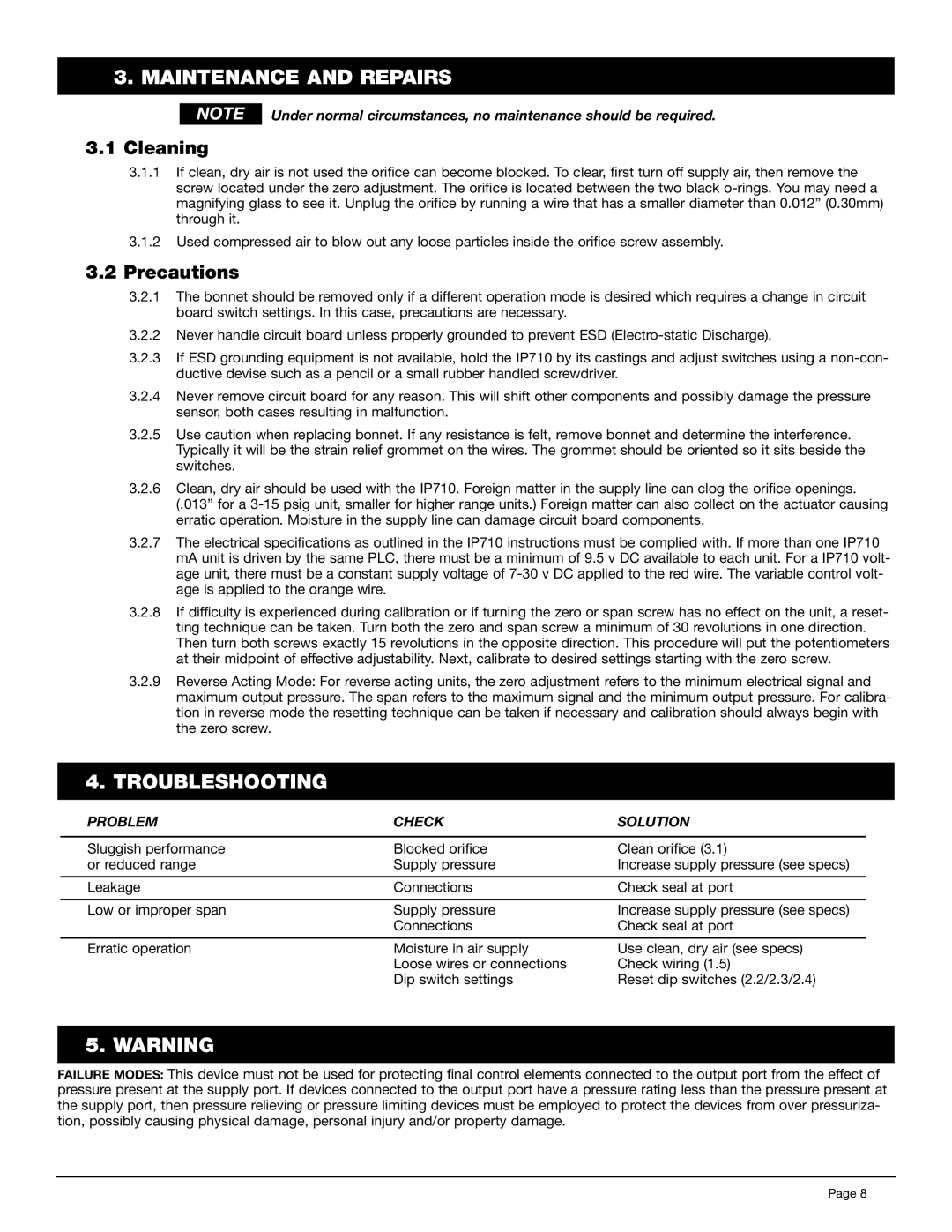
3. MAINTENANCE AND REPAIRS
NOTE Under normal circumstances, no maintenance should be required.
3.1Cleaning
3.1.1If clean, dry air is not used the orifice can become blocked. To clear, first turn off supply air, then remove the screw located under the zero adjustment. The orifice is located between the two black
3.1.2Used compressed air to blow out any loose particles inside the orifice screw assembly.
3.2Precautions
3.2.1The bonnet should be removed only if a different operation mode is desired which requires a change in circuit board switch settings. In this case, precautions are necessary.
3.2.2Never handle circuit board unless properly grounded to prevent ESD
3.2.3If ESD grounding equipment is not available, hold the IP710 by its castings and adjust switches using a
3.2.4Never remove circuit board for any reason. This will shift other components and possibly damage the pressure sensor, both cases resulting in malfunction.
3.2.5Use caution when replacing bonnet. If any resistance is felt, remove bonnet and determine the interference. Typically it will be the strain relief grommet on the wires. The grommet should be oriented so it sits beside the switches.
3.2.6Clean, dry air should be used with the IP710. Foreign matter in the supply line can clog the orifice openings. (.013” for a
3.2.7The electrical specifications as outlined in the IP710 instructions must be complied with. If more than one IP710 mA unit is driven by the same PLC, there must be a minimum of 9.5 v DC available to each unit. For a IP710 volt- age unit, there must be a constant supply voltage of
3.2.8If difficulty is experienced during calibration or if turning the zero or span screw has no effect on the unit, a reset- ting technique can be taken. Turn both the zero and span screw a minimum of 30 revolutions in one direction. Then turn both screws exactly 15 revolutions in the opposite direction. This procedure will put the potentiometers at their midpoint of effective adjustability. Next, calibrate to desired settings starting with the zero screw.
3.2.9Reverse Acting Mode: For reverse acting units, the zero adjustment refers to the minimum electrical signal and maximum output pressure. The span refers to the maximum signal and the minimum output pressure. For calibra- tion in reverse mode the resetting technique can be taken if necessary and calibration should always begin with the zero screw.
4. TROUBLESHOOTING
PROBLEM | CHECK | SOLUTION |
|
|
|
Sluggish performance | Blocked orifice | Clean orifice (3.1) |
or reduced range | Supply pressure | Increase supply pressure (see specs) |
|
|
|
Leakage | Connections | Check seal at port |
|
|
|
Low or improper span | Supply pressure | Increase supply pressure (see specs) |
| Connections | Check seal at port |
|
|
|
Erratic operation | Moisture in air supply | Use clean, dry air (see specs) |
| Loose wires or connections | Check wiring (1.5) |
| Dip switch settings | Reset dip switches (2.2/2.3/2.4) |
5. WARNING
FAILURE MODES: This device must not be used for protecting final control elements connected to the output port from the effect of pressure present at the supply port. If devices connected to the output port have a pressure rating less than the pressure present at the supply port, then pressure relieving or pressure limiting devices must be employed to protect the devices from over pressuriza- tion, possibly causing physical damage, personal injury and/or property damage.
Page 8
